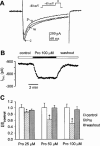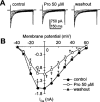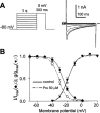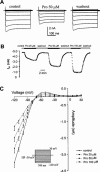Electrophysiological effects of protopine in cardiac myocytes: inhibition of multiple cation channel currents
- PMID: 10696087
- PMCID: PMC1571915
- DOI: 10.1038/sj.bjp.0703132
Electrophysiological effects of protopine in cardiac myocytes: inhibition of multiple cation channel currents
Abstract
Protopine (Pro) from Corydalis tubers has been shown to have multiple actions on cardiovascular system, including anti-arrhythmic, anti-hypertensive and negative inotropic effects. Although it was thought that Pro exerts its actions through blocking Ca(2+) currents, the electrophysiological profile of Pro is unclear. The aim of this study is to elucidate the ionic mechanisms of Pro effects in the heart. In single isolated ventricular myocytes from guinea-pig, extracellular application of Pro markedly and reversibly abbreviates action potential duration, and decreases the rate of upstroke (dV/dt)(max), amplitude and overshoot of action potential in a dose-dependent manner. Additionally, it produces a slight, but significant hyperpolarization of the resting membrane potential. Pro at 25, 50 and 100 microM reduces L-type Ca(2+) current (I(Ca,L)) amplitude to 89.1, 61.9 and 45.8% of control, respectively, and significantly slows the decay kinetics of I(Ca,L) at higher concentration. The steady state inactivation of I(Ca,L) is shifted negatively by 5.9 - 7.0 mV (at 50 - 100 microM Pro), whereas the voltage-dependent activation of I(Ca,L) remains unchanged. In contrast, Pro at 100 microM has no evident effects on T-type Ca(2+) current (I(Ca,T)). In the presence of Pro, both the inward rectifier (I(K1)) and delayed rectifier (I(K)) potassium currents are variably inhibited, depending on Pro concentrations. Sodium current (I(Na)), recorded in low [Na(+)](o) (40 mM) solution, is more potently suppressed by Pro. At 25 microM, Pro significantly attenuated I(Na) at most of the test voltages (-60 approximately +40 mV, with a 53% reduction at -30 mV. Thus, Pro is not a selective Ca(2+) channel antagonist. Rather, it acts as a promiscuous inhibitor of cation channel currents including I(Ca,L), I(K), I(K1) as well as I(Na). These findings may provide some mechanistic explanations for the therapeutic actions of Pro in the heart.
Figures








Similar articles
-
Ionic mechanisms mediating the differential effects of methohexital and thiopental on action potential duration in guinea pig and rabbit isolated ventricular myocytes.Anesthesiology. 1999 Jan;90(1):156-64. doi: 10.1097/00000542-199901000-00021. Anesthesiology. 1999. PMID: 9915324
-
Xenon does not alter cardiac function or major cation currents in isolated guinea pig hearts or myocytes.Anesthesiology. 2000 Feb;92(2):516-22. doi: 10.1097/00000542-200002000-00035. Anesthesiology. 2000. PMID: 10691240
-
Electrophysiological properties of neonatal mouse cardiac myocytes in primary culture.J Physiol. 1994 Sep 1;479 ( Pt 2)(Pt 2):265-79. doi: 10.1113/jphysiol.1994.sp020294. J Physiol. 1994. PMID: 7799226 Free PMC article.
-
KB130015, a new amiodarone derivative with multiple effects on cardiac ion channels.Cardiovasc Drug Rev. 2003 Fall;21(3):216-35. doi: 10.1111/j.1527-3466.2003.tb00117.x. Cardiovasc Drug Rev. 2003. PMID: 12931255 Review.
-
Cardiac strong inward rectifier potassium channels.J Mol Cell Cardiol. 2010 Jan;48(1):45-54. doi: 10.1016/j.yjmcc.2009.08.013. Epub 2009 Aug 22. J Mol Cell Cardiol. 2010. PMID: 19703462 Free PMC article. Review.
Cited by
-
Identification and characterization of a dual-acting antinematodal agent against the pinewood nematode, Bursaphelenchus xylophilus.PLoS One. 2009 Nov 11;4(11):e7593. doi: 10.1371/journal.pone.0007593. PLoS One. 2009. PMID: 19907651 Free PMC article.
-
Identification of a novel bacterial K(+) channel.J Membr Biol. 2011 Aug;242(3):153-64. doi: 10.1007/s00232-011-9386-2. Epub 2011 Jul 9. J Membr Biol. 2011. PMID: 21744086
-
Medicine in motion: Opportunities, challenges and data analytics-based solutions for traditional medicine integration into western medical practice.J Ethnopharmacol. 2021 Mar 1;267:113477. doi: 10.1016/j.jep.2020.113477. Epub 2020 Oct 21. J Ethnopharmacol. 2021. PMID: 33098971 Free PMC article. Review.
-
A review on plants and herbal components with antiarrhythmic activities and their interaction with current cardiac drugs.J Tradit Complement Med. 2020 Apr 6;10(3):275-287. doi: 10.1016/j.jtcme.2020.03.002. eCollection 2020 May. J Tradit Complement Med. 2020. PMID: 32670823 Free PMC article. Review.
-
Sanguinaria canadensis: Traditional Medicine, Phytochemical Composition, Biological Activities and Current Uses.Int J Mol Sci. 2016 Aug 27;17(9):1414. doi: 10.3390/ijms17091414. Int J Mol Sci. 2016. PMID: 27618894 Free PMC article. Review.
References
-
- BERLIN J.R., CANNELL M.B., LEDERER W.J. Cellular origins of the transient inward current in cardiac myocytes. Role of fluctuations and waves of elevated intracellular calcium. Circ. Res. 1989;65:115–126. - PubMed
-
- BURTSEV V.N., DORMIDONTOV E.N., SALIAEV V.N. Prevention of ventricular fibrillation with the aid of protopine in animal experiments. Kardiologiia. 1978;18:76–79. - PubMed
-
- EISNER D.A., TRAFFORD A.W., DIAZ M.E., OVEREND C.L., O'NEILL S.C. The control of Ca release from the cardiac sacroplasmic reticulum: regulation versus autoregulation. J. Physiol. 1998;38:589–604. - PubMed
-
- FABIATO A. Calcium-induced release of calcium from the cardiac sarcoplasmic reticulum. Am. J. Physiol. 1983;245:C1–C14. - PubMed
Publication types
MeSH terms
Substances
LinkOut - more resources
Full Text Sources
Miscellaneous

